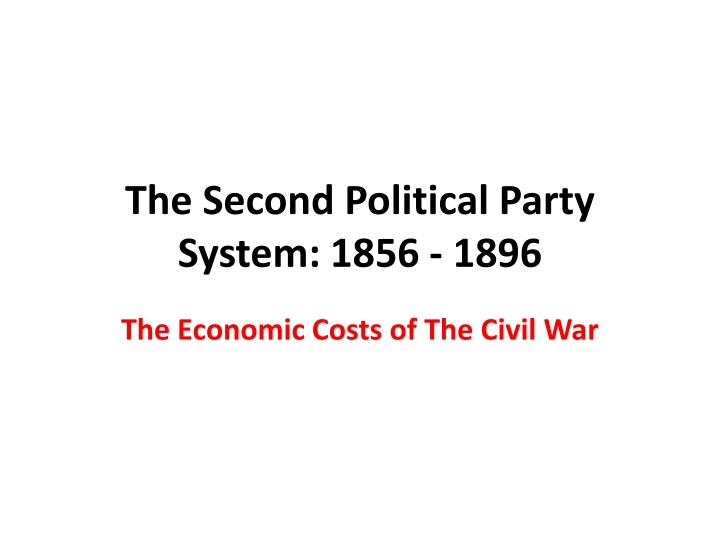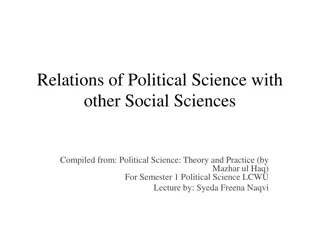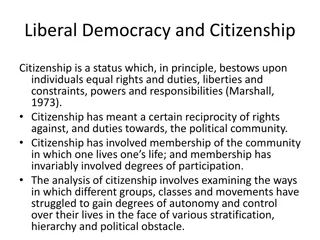
Economic Costs of the Civil War: Impact and Aftermath 1856-1896
Explore the economic costs of the Civil War from 1856 to 1896, detailing the direct and indirect costs for the North and South, the magnitude of these costs compared to government expenditures and more. Discover the long-term consequences on American life and the significant impact on the economic development of the North and South.
Download Presentation

Please find below an Image/Link to download the presentation.
The content on the website is provided AS IS for your information and personal use only. It may not be sold, licensed, or shared on other websites without obtaining consent from the author. If you encounter any issues during the download, it is possible that the publisher has removed the file from their server.
You are allowed to download the files provided on this website for personal or commercial use, subject to the condition that they are used lawfully. All files are the property of their respective owners.
The content on the website is provided AS IS for your information and personal use only. It may not be sold, licensed, or shared on other websites without obtaining consent from the author.
E N D
Presentation Transcript
The Second Political Party System: 1856 - 1896 The Economic Costs of The Civil War
DIMENSIONS OF THE WAR 1) Largest Land Armies assembled in Human history -- by 1863 the North had 1,000,000 men under arms and the South 650,000. 2) Battles involving over 100,000 men were commonplace and some reached 200,000. 3) In one day, nearly 5,000 men were killed at Antietam and 20,000 wounded. It is still the most American soldiers killed in one day. 4) Total Dead: 360,000 North + 258,000 South = 618,000 with at least 500,000 wounded.
Direct Costs of the War for North & South Direct Cost = All War Spending by Government + Destroyed Physical Capital + Destroyed Human Capital. Summary of Direct Costs (From Goldin and Lewis) NORTH SOUTH Government 2,292 1,011 Draft 11(162,000 men) 20(300,000 men) Physical Capital Destruction -- 1,487 Human Capital Destruction: Killed 955 684 : Wounded 365 261 Risk Premiums -256 -178 TOTAL $3.367b $3.285b GRAND TOTAL $6,652,000,000
Magnitude of Direct Costs: 4 times all government expenditures, 1789 to 1860; 17 times 1860 export earnings; could have purchased all the Slaves at prevailing market prices, given each family 40 acres and a mule, and still have $3.5 billion left over.
Indirect Costs: Hypothetical (consumption if no War) versus actual consumption over time discounted by prevailing interest rate. This shows that the costs for the North were $5.2b and the South $9.5b for a total of $14.7b.
Long-Run Impact of the War on American Life The North Became an Industrial Superpower -- The Northern United States became the largest Economy in the World in 1892 The South Became a Third World Country within the Geographic Boundaries of the United States. No Significant Economic Activity until Oil was Struck at Spindletop, Texas, on 10 January 1901.
The Discovery of Oil at Spindletop, Texas, 10 January 1901
Presidential Elections: 1864 - 1896 Democrat Republican --------------------------------------------------------------------------- 1864 McClellan 21 1,836,072 44.91 Lincoln 212 2,220,846 55.08* 1868 Seymour 80 2,708,744 47.29 Grant 214 3,013,650 52.70* 1872 Greeley --- 2,835,315 43.82 Grant 286 3,598,468 55.63* 1876 Tilden 184 4,288,191 51.01* Hayes 185 4,033,497 47.87 1880 Hancock 155 4,445,526 48.21 Garfield 214 4,453,611 48.31 1884 Cleveland 219 4,915,586 48.49 Blaine 182 4,852,916 48.26 1888 Cleveland 168 5,539,118 48.68 Harrison 233 5,449,825 47.79 1892 Cleveland 277 5,554,617 46.07 Harrison 145 5,186,793 42.92 1896 Bryan 176 6,370,897 46.70 McKinley 271 7,105,144 51.02* ---------------------------------------------------------------------------
Congressional Elections: 1854 - 1896 HOUSE SENATE Democrat Opposition Democrat Opposition Republican Republican 1854 83 100 (51A) 39 22 (1A) 1856 132 90 (14A,1) 41 20 (5A) 1858 83 116 (5A,36) 38 26 (2A,2) ----------------------------------------------------------------------- Democrat Republican Unionist Democrat Republican Unionist 1860 44 108 30 (1I) 15 31 3 1862 72 85 25 (2IR) 10 33 5 1864 38 136 18 (1IR) 11 39 4 ----------------------------------------------------------------------- 1866 47 173 (6) 9 57 (2 Vacant) 1868 67 171 24 (5C) 12 62 1870 104 136 (3IR) 17 57 1872 88 199 (4LR,1ID) 19 54 (1 Vacant) 1874 183 106 (1I) 28 47 (1 Vacant) 1876 157 136 35 40 (1I) ----------------------------------------------------------------------- 1878 148 132 (13NL) 42 33 (1I) 1880 129 151 (10NL,2J,1I) 37 37 (1I,1J) 1882 199 118 (4J,2I,2NL) 36 38 (2J) 1884 183 141 (1NL) 34 42 1886 167 154 (2L,1NL,1I) 37 39 1888 152 179 (1L) 37 51 1890 238 86 (8P) 39 47 (2P) 1892 220 124 (11P,2S) 44 40 (3P,1S) 1894 93 254 (9P,1S) 40 44 (4P,2S) 1896 124 207 (22P,1S,3SR) 34 44 (5P,2S,5SR) ----------------------------------------------------------------------
The Disputed 1876 Election Early Returns Tilden 184 Hayes 165 Disputed Electoral Votes Florida 4 Louisiana 8 Oregon 1 South Carolina 7 ------------------- 20






















